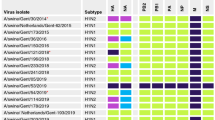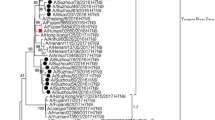Abstract
Eurasian avian-like H1N1 (EA H1N1) swine influenza virus (SIV) outside European countries was first detected in Hong Kong Special Administrative Region (Hong Kong, SAR) of China in 2001. Afterwards, EA H1N1 SIVs have become predominant in pig population in this country. However, the epidemiology and genotypic diversity of EA H1N1 SIVs in China are still unknown. Here, we collected the EA H1N1 SIVs sequences from China between 2001 and 2018 and analyzed the epidemic and phylogenic features, and key molecular markers of these EA H1N1 SIVs. Our results showed that EA H1N1 SIVs distributed in nineteen provinces/municipalities of China. After a long-time evolution and transmission, EA H1N1 SIVs were continuously reassorted with other co-circulated influenza viruses, including 2009 pandemic H1N1 (A(H1N1)pdm09), and triple reassortment H1N2 (TR H1N2) influenza viruses, generated 11 genotypes. Genotype 3 and 5, both of which were the reassortments among EA H1N1, A(H1N1)pdm09 and TR H1N2 viruses with different origins of M genes, have become predominant in pig population. Furthermore, key molecular signatures were identified in EA H1N1 SIVs. Our study has drawn a genotypic diversity image of EA H1N1 viruses, and could help to evaluate the potential risk of EA H1N1 for pandemic preparedness and response.




Similar content being viewed by others
References
Anderson TK, Macken CA, Lewis NS, Scheuermann RH, Reeth KV, Brown IH, Swenson SL, Simon G, Saito T, Berhane Y, Ciacci-Zanella J, Pereda A, Davis CT, Donis RO, Webby RJ, Vincent AL (2016) A phylogeny-based global nomenclature system and automated annotation tool for H1 hemagglutinin genes from swine influenza A viruses. MSphere 1:e00216–e00275
Babu YS, Chand P, Bantia S, Kotian P, Dehghani A, El-Kattan Y, Lin TH, Hutchison TL, Elliott AJ, Parker CD (2001) BCX-1812 (RWJ-270201): discovery of a novel, highly potent, orally active, and selective influenza neuraminidase inhibitor through structure-based drug design. J Med Chem 32:3482
Bussey KA, Bousse TL, Desmet EA, Kim B, Takimoto T (2010) PB2 residue 271 plays a key role in enhanced polymerase activity of influenza A viruses in mammalian host cells. J Virol 84:4395–4406
Campbell PJ, Kyriakis CS, Marshall N, Suppiah S, Seladi-Schulman J, Danzy S, Lowen AC, Steel J (2014) Residue 41 of the Eurasian avian-like swine influenza a virus matrix protein modulates virion filament length and efficiency of contact transmission. J Virol 88:7569–7577
Campitelli L, Donatelli I, Foni E, Castrucci MR, Fabiani C, Kawaoka Y, Krauss S, Webster RG (1997) Continued evolution of H1N1 and H3N2 influenza viruses in pigs in Italy. Virology 232:310–318
Chen H, Bright RA, Subbarao K, Smith C, Cox NJ, Katz JM, Matsuoka Y (2007) Polygenic virulence factors involved in pathogenesis of 1997 Hong Kong H5N1 influenza viruses in mice. Virus Res 128:159–163
Chen Y, Zhang J, Qiao CL, Yang HL, Zhang Y, Xin XG, Chen HL (2013) Co-circulation of pandemic 2009 H1N1, classical swine H1N1 and avian-like swine H1N1 influenza viruses in pigs in China. Infect Genet Evol 13:331–338
Gregory V, Bennett M, Thomas Y, Kaiser L, Wunderli W, Matter H, Hay A, Lin YP (2003) Human infection by a swine influenza A (H1N1) virus in Switzerland. Arch Virol 148:793–802
Hay AJ, Wolstenholme AJ, Skehel JJ, Smith MH (1985) The molecular basis of the specific anti-influenza action of amantadine. EMBO J 4:3021–3024
He P, Wang GJ, Mo YN, Yu Q, Xiao X, Yang WJ, Zhao WF, Guo X, Chen Q, He JQ, Liang ML, Zhu J, Ding YB, Wei ZZ, Ouyang K, Liu F, Jian H, Huang WJ, Garcia-Sastre A, Chen Y (2018) Novel triple-reassortant influenza viruses in pigs, Guangxi, China. Emerg Microbes Infect 7:85
Ito T, Suzuki Y, Mitnaul L, Vines A, Kida H, Kawaoka Y (1997) Receptor specificity of influenza A viruses correlates with the agglutination of erythrocytes from different animal species. Virology 227:493–499
Ives JAL, Carr JA, Mendel DB, Tai CY, Lambkin R, Kelly L, Oxford JS, Hayden FG, Roberts NA (2002) The H274Y mutation in the influenza A/H1N1 neuraminidase active site following oseltamivir phosphate treatment leave virus severely compromised both in vitro and in vivo. Antivir Res 55:307–317
Kazutaka K, Standley DM (2013) MAFFT multiple sequence alignment software version 7: improvements in performance and usability. Mol Biol Evol 30:772–780
Liu JH, Bi YH, Qin K, Fu GH, Yang J, Peng JS, Ma GP, Liu QF, Pu J, Tian FL (2009) Emergence of European avian influenza virus-like H1N1 swine influenza A viruses in China. J Clin Microbiol 47:2643–2646
Liu SL, Zhu WF, Feng ZM, Gao RB, Guo JF, Li XY, Liu J, Wang DY, Shu YL (2018) Substitution of D701N in the PB2 protein could enhance the viral replication and pathogenicity of Eurasian avian-like H1N1 swine influenza viruses. Emerg Microbes Infect 7:75
Pensaert M, Ottis K, Vandeputte J, Kaplan MM, Bachmann PA (1981) Evidence for the natural transmission of influenza A virus from wild ducts to swine and its potential importance for man. Bull World Health Organ 59:75–78
Scholtissek C, Bürger H, Bachmann PA, Hannoun C (1983) Genetic relatedness of hemagglutinins of the H1 subtype of influenza a viruses isolated from swine and birds. Virology 129:521–523
Scholtissek C, Bürger H, Kistner O, Shortridge KF (1985) The nucleoprotein as a possible major factor in determining host specificity of influenza H3N2 viruses. Virology 147:287–294
Shiraishi K, Mitamura K, Sakai-Tagawa Y, Goto H, Sugaya N, Kawaoka Y (2003) High frequency of resistant viruses harboring different mutations in amantadine-treated children with influenza. J Infect Dis 188:57–61
Smith GJD, Vijaykrishna D, Bahl J, Lycett SJ, Worobey M, Pybus OG, Ma SK, Cheung CL, Raghwani J, Bhatt S, Peiris JSM, Guan Y, Rambaut A (2009) Origins and evolutionary genomics of the 2009 swine-origin H1N1 influenza A epidemic. Nature 459:1122–1125
Steel J, Lowen AC, Mubareka S, Palese P, Baric RS (2009) Transmission of influenza virus in a mammalian host is increased by PB2 amino acids 627 K or 627E/701N. PLoS Pathog 5:e1000252
Sun YF, Wang XH, Li XL, Zhang L, Li HH, Lu C, Yang CL, Feng J, Han W, Ren WK, Tian XX, Tong GZ, Wen F, Li ZJ, Gong XQ, Liu XM, Ruan BY, Yan MH, Yu H (2016) Novel triple-reassortant H1N1 swine influenza viruses in pigs in Tianjin, Northern China. Vet Microbiol 183:85–91
Suzuki T, Horiike G, Yamazaki Y, Kawabe K, Masuda H, Miyamoto D, Matsuda M, Nishimura S-I, Yamagata T, Ito T, Kida H, Kawaoka Y, Suzuki Y (1997) Swine influenza virus strains recognize sialylsugar chains containing the molecular species of sialic acid predominantly present in the swine tracheal epithelium. FEBS Lett 404:192–196
Tumpey TM, Maines TR, Van Hoeven N, Glaser L, Solorzano A, Pappas C, Cox NJ, Swayne DE, Palese P, Katz JM (2007) A two-amino acid change in the hemagglutinin of the 1918 influenza virus abolishes transmission. Science 315:655–659
Vijaykrishna D, Smith GJD, Pybus OG, Zhu H, Bhatt S, Poon LLM, Riley S, Bahl J, Ma SK, Cheung CL, Perera RAPM, Chen H, Shortridge KF, Webby RJ, Webster RG, Guan Y, Peiris JSM (2011) Long-term evolution and transmission dynamics of swine influenza A virus. Nature 473:519–522
Wang DY, Qi SX, Li XY, Guo JF, Tan MJ, Han GY, Liu YF, Lan Y, Yang L, Huang WJ, Cheng YH, Zhao X, Bai T, Wang Z, Wei HJ, Xiao N, Shu YL (2013) Human infection with Eurasian avian-like influenza A(H1N1) virus, China. Emerg Infect Dis 19:1709–1711
Xie JF, Zhang YH, Zhao L, Xiu WQ, Chen HB, Lin Q, Weng YW, Zheng KC (2018) Emergence of Eurasian avian-like swine influenza A (H1N1) virus from an adult case in Fujian Province, China. Virol Sin 33:282–286
Xu C, Hu WB, Xu K, He YX, Wang TY, Chen Z, Li TX, Liu JH, Buchy P, Sun B (2011) Amino acids 473 V and 598P of PB1 from an avian-origin influenza A virus contribute to polymerase activity, especially in mammalian cells. J Gen Virol 93:531–540
Xu G, Zhang X, Gao W, Wang C, Wang J, Sun H, Sun Y, Guo L, Zhang R, Chang K-C, Liu J, Pu J, Lyles DS (2016) Prevailing PA mutation K356R in avian influenza H9N2 virus increases mammalian replication and pathogenicity. J Virol 90:8105–8114
Yamada S, Hatta M, Staker BL, Watanabe S, Imai M, Shinya K, Sakai-Tagawa Y, Ito M, Ozawa M, Watanabe T, Sakabe S, Li C, Kim JH, Myler PJ, Phan I, Raymond A, Smith E, Stacy R, Nidom CA, Lank SM, Wiseman RW, Bimber BN, O’Connor DH, Neumann G, Stewart LJ, Kawaoka Y (2010) Biological and structural characterization of a host-adapting amino acid in influenza virus. PLoS Pathog 6:e1001034
Yang HL, Qiao CL, Tang X, Chen Y, Xin XG, Chen HL (2012) Human infection from avian-like influenza A (H1N1) viruses in pigs, China. Emerg Infect Dis 18:1144–1146
Yang HL, Chen Y, Qiao CL, He XJ, Zhou H, Sun Y, Yin H, Meng SS, Liu LP, Zhang QY, Kong HH, Gu CY, Li CJ, Bu ZG, Kawaoka Y, Chen HL (2016) Prevalence, genetics, and transmissibility in ferrets of Eurasian avian-like H1N1 swine influenza viruses. Proc Natl Acad Sci U S A 113:392–397
Zhu HC, Zhou BP, Fan XH, Lam TTY, Wang J, Chen A, Chen XC, Chen HL, Webster RG, Webby R, Peiris JSM, Smith DK, Guan Y (2011) Novel reassortment of Eurasian avian-like and pandemic/2009 influenza viruses in swine: infectious potential for humans. J Virol 85:10432–10439
Zhu WF, Li L, Yan ZG, Gan TH, Li LF, Chen RR, Chen RD, Zheng ZY, Hong WS, Wang J, Smith DK, Guan Y, Zhu HC, Shu YL (2015) Dual E627K and D701N mutations in the PB2 protein of A(H7N9) influenza virus increased its virulence in mammalian models. Sci Rep 5:14170
Zhu WF, Zhang H, Xiang XY, Zhong LL, Yang L, Guo JF, Xie YR, Li FC, Deng ZH, Feng H, Huang YW, Hu SX, Xu X, Zou XH, Li XD, Bai T, Chen YK, Li Z, Li JH, Shu YL (2016) Reassortant Eurasian avian-like influenza A(H1N1) virus from a severely ill child, Hunan Province, China, 2015. Emerg Infect Dis 22:1930–1936
Zhu WF, Feng ZM, Chen YK, Yang L, Liu J, Li XY, Liu SL, Zhou LJ, Wei HJ, Gao RB, Wang DY, Shu YL (2019) Mammalian-adaptive mutation NP-Q357K in Eurasian H1N1 swine influenza viruses determines the virulence phenotype in mice. Emerg Microbes Infect 8:989–999
Acknowledgements
We gratefully acknowledge the authors and laboratories for sharing the EA SIVs sequences in GISAID and GenBank database. The contents of this article are solely the responsibility of the authors and do not necessarily represent the views of China CDC and other organizations. The study was supported by the National Nature Science Foundation of China (81961128002, 81971941, and 31761133003).
Author information
Authors and Affiliations
Contributions
YS, DW, and WZ designed the study; YS, WZ, ZF, LY, JL, and LZ analyzed the data and discussed the results; ZF wrote the manuscript; YS and WZ finalized the manuscript.
Corresponding authors
Ethics declarations
Conflict of interest
The authors declared that they have no conflicts of interest.
Animal and Human Rights Statement
This article does not contain any studies with human or animal subjects performed by any of the authors.
Electronic supplementary material
Below is the link to the electronic supplementary material.
Rights and permissions
About this article
Cite this article
Feng, Z., Zhu, W., Yang, L. et al. Epidemiology and Genotypic Diversity of Eurasian Avian-Like H1N1 Swine Influenza Viruses in China. Virol. Sin. 36, 43–51 (2021). https://doi.org/10.1007/s12250-020-00257-8
Received:
Accepted:
Published:
Issue Date:
DOI: https://doi.org/10.1007/s12250-020-00257-8




